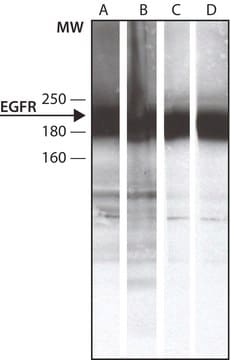16-103
Anti-Phosphotyrosine Antibody, clone 4G10®, Biotin Conjugate
clone 4G10®, Upstate®, from mouse
Sinonimo/i:
4G10 Biotin Antibody, Biotinylated Anti-Phosphotyrosine, Clone 4G10 Anti-Phosphotyrosine
About This Item
Prodotti consigliati
Origine biologica
mouse
Livello qualitativo
Coniugato
biotin conjugate
Forma dell’anticorpo
purified antibody
Tipo di anticorpo
primary antibodies
Clone
4G10®, monoclonal
Reattività contro le specie
human
Reattività contro le specie (prevista in base all’omologia)
all
Produttore/marchio commerciale
Upstate®
tecniche
immunocytochemistry: suitable
immunoprecipitation (IP): suitable
western blot: suitable
Isotipo
IgG2bκ
Condizioni di spedizione
wet ice
modifica post-traduzionali bersaglio
phosphorylation (pTyr)
Informazioni sul gene
human ... PID1(55022)
Descrizione generale
Description
Anti-phosphotyrosine monoclonal antibody, clone 4G10 (cat. # 05-321), cross-linked to biotin.
Specificità
Immunogeno
Applicazioni
4 μg of a previous lot, used in conjunction with Streptavidin, agarose conjugate (Catalog # 16-126), immunoprecipitated phosphotyrosine containing proteins from a lysate of EGFstimulated A431 cells.
Note: To preserve phosphotyrosine, add 0.2 mM sodium orthovanadate to the lysis buffer.
Immunocytochemistry:
5-10 μg/mL of a previous lot gave positive immunostaining of EGF-stimulated A431 cells that had been fixed with ethanol:acetic acid [1:1].
Application Notes
For use in applications in which a biotin conjugate is advantageous, such as WB and IC.
Signaling
General Post-translation Modification
Qualità
Western Blot Analysis:
1:500 dilution of this lot detected Tyrosine phosphorylated proteins on 10 μg of EGF treated A431 lysates.
Descrizione del bersaglio
Stato fisico
Stoccaggio e stabilità
Risultati analitici
Pervanadate-treated human A431 cell extracts or EGF-treated human A431 cells
Altre note
Note legali
Esclusione di responsabilità
Not finding the right product?
Try our Motore di ricerca dei prodotti.
Codice della classe di stoccaggio
12 - Non Combustible Liquids
Classe di pericolosità dell'acqua (WGK)
WGK 2
Punto d’infiammabilità (°F)
Not applicable
Punto d’infiammabilità (°C)
Not applicable
Certificati d'analisi (COA)
Cerca il Certificati d'analisi (COA) digitando il numero di lotto/batch corrispondente. I numeri di lotto o di batch sono stampati sull'etichetta dei prodotti dopo la parola ‘Lotto’ o ‘Batch’.
Possiedi già questo prodotto?
I documenti relativi ai prodotti acquistati recentemente sono disponibili nell’Archivio dei documenti.
Il team dei nostri ricercatori vanta grande esperienza in tutte le aree della ricerca quali Life Science, scienza dei materiali, sintesi chimica, cromatografia, discipline analitiche, ecc..
Contatta l'Assistenza Tecnica.








